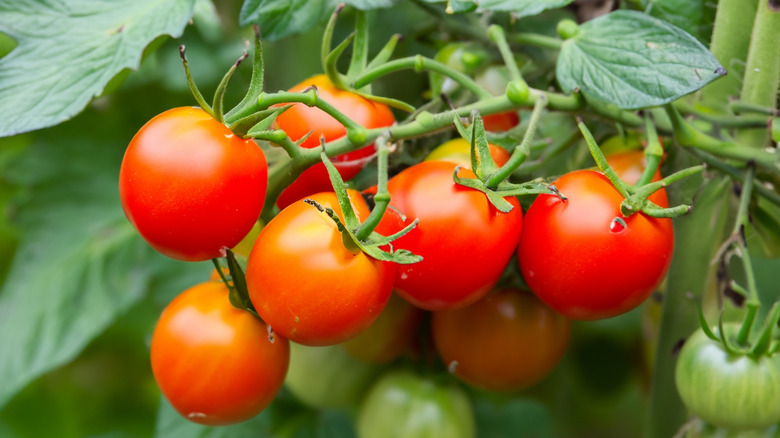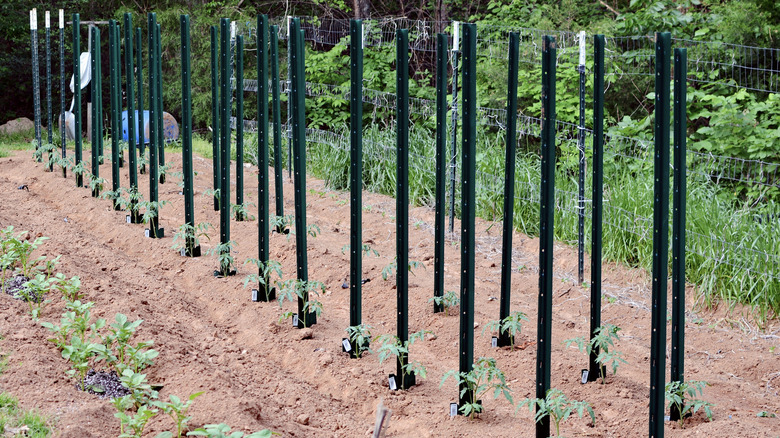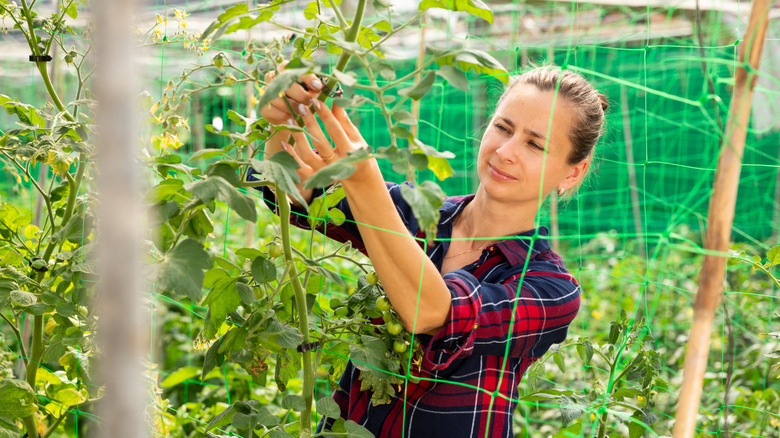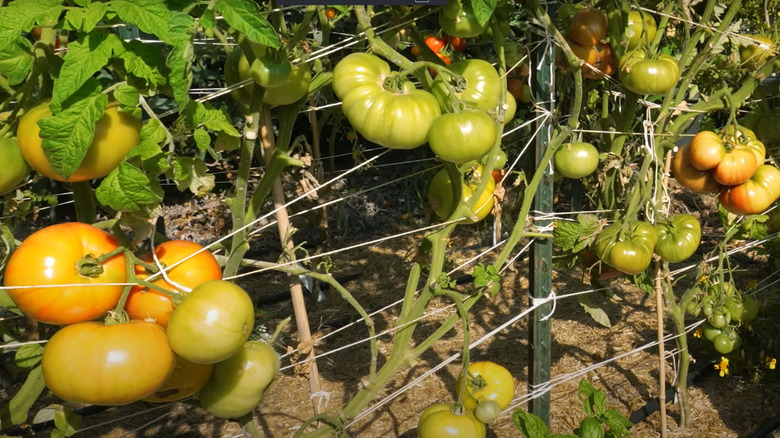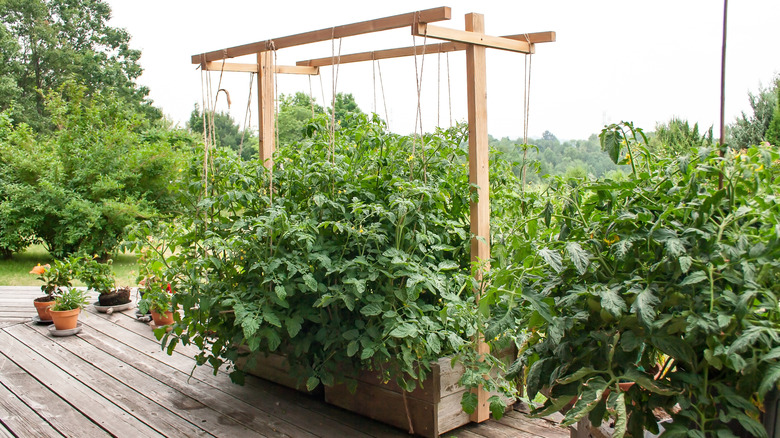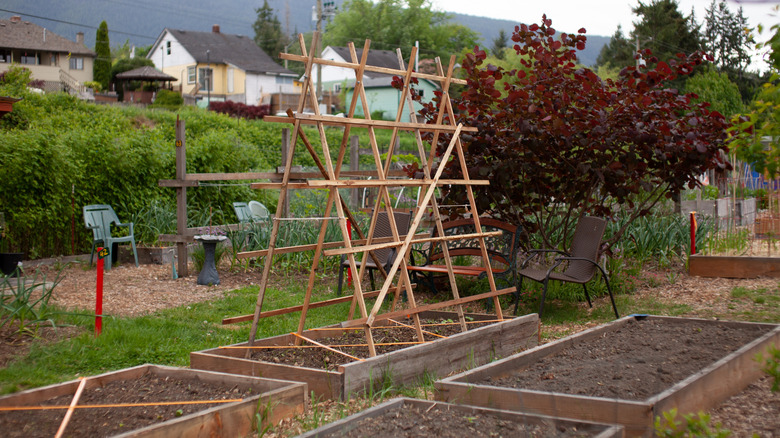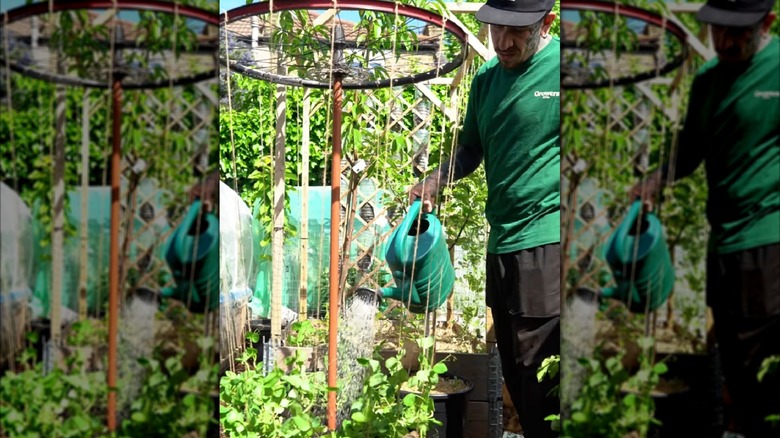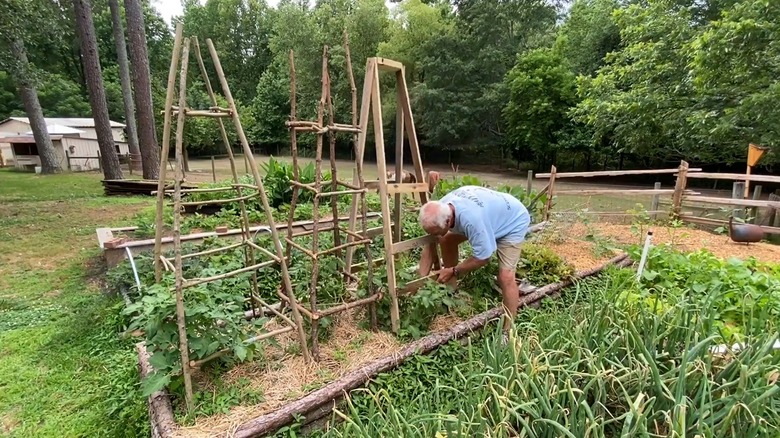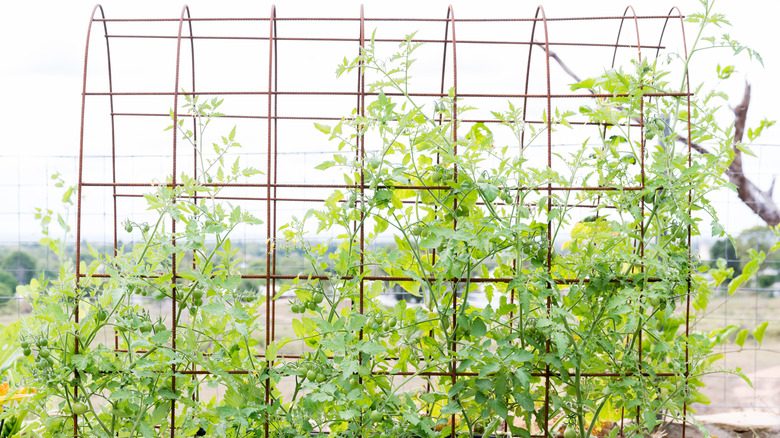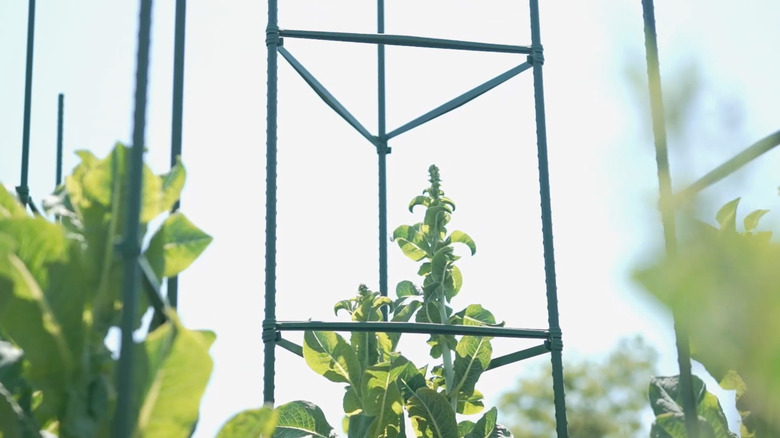10 Alternative Ways To Stake Tomato Plants For Healthier Growth
We may receive a commission on purchases made from links.
Maybe you've seen some videos out there warning you not to cage your tomato plants. Many gardeners opt to ditch the tomato cage because they find that they can be more expensive than other options, and they don't always provide the support needed for heavy tomato plant vines, especially fast growers. There are many alternatives to tomato cages, such as bamboo posts or metal stakes or even up-cycled bicycle wheels, that will help you grow healthier tomatoes.
Supporting tomatoes is important in the growing process. Tomato varieties and sizes can vary, but almost all of them need support as they grow. Trellising or staking tomatoes is important because it prevents vegetable rot, but it can also head off disease. Keeping fruit off the ground encourages good air circulation, which is key to preventing infections like leaf mold.
While tomato caging is a traditional method of support, many gardeners have soured on the strategy. Tomato cages can bend under the weight of tomatoes rather quickly. Plum tomatoes, for example, can grow in heavy clusters of tomatoes five inches long that might topple a flimsy tomato cage. Worse, if plants grow too large for the cage, they can become crowded inside it, and that can lead to fungus growth or other disease, the very thing you're trying to prevent. That's why we've gathered 10 of the best alternatives to tomato caging here that will help keep your tomato plants healthy and your harvests high.
Use thick bamboo as a tomato stake
One of the simplest ways to support your tomato vine is with a single bamboo stake. It's one of many handy uses for bamboo plants. Staking keeps plants upright and is likely to increase your tomato yield since this ensures your plants get more sun. Make sure you section your bamboo poles (and your tomato plants) about 2 feet apart, and each pole should be about 3 inches from the plant. Drive the pole into the ground and then use twine or ribbon to fasten the vines to the pole as they grow.
Metal stakes are also great supports
If you're worried about the bamboo breaking under the weight of your tomato plants, try metal stakes. They're unlikely to bend or break. Metal stakes are one of the most durable and weatherproof of any staking material and should last the longest in your garden. You'll want to wait until your tomato plant is about a foot or so tall before strapping it to the stake (with either twine or ribbon) and then keep on securing the plant to the post about every ten inches or so as it grows.
Try a tomato net as a trellis
If you've got sprawling tomato plants, a netting tomato trellis might be the best option. All you need is some netting and two poles, either bamboo or metal. Just stake the poles in the ground on either end of your plants and attach the netting in between. You can buy vinyl weatherproof vegetable netting for under $8 at your local hardware or garden center. You'll also need tomato clips to attach the vines to the netting for support. The clip needs to be strong enough to hold the vine but not crush it.
Use the Florida weave trellis method
If you want to create your own kind of net, try the Florida weave method of trellising tomato plants. It involves tying string horizontally between two metal stakes. Metal stakes are a little more stable than wooden or bamboo ones for this method. It's called a weave because you'll be intertwining the string through the tomato plant vines and fruit to act as a support. You'll want an inch or two between each row of string. Remember to keep the tension on the string tight or it won't act as a proper support.
Make a vertical string trellis
Twine or string might not seem strong enough to keep tomato plants supported, but the string method has been used in commercial greenhouses for years. With a string trellis you run the string vertically from the top of a wooden structure, straight down to the ground, where it's secured by tying loosely around the base of your tomato plant. Tomato plants shouldn't be too tightly secured. They need a little give or you might have problems with them not pollinating. Tomato plants are self-pollinating, but they usually count on a breeze to distribute pollen.
Build a wooden A-frame trellis
A free-standing A-frame trellis for your tomato plants is another great alternative to tomato cages. You might even be able to use scrap wood you've already got lying around. You'll want to put it up in early spring even before you plant your tomatoes. Ideally, you want a frame that comes apart easily so you can take down and store it away in the winter time. This support will give your plants plenty of healthy air circulation and not let your tomatoes get too bogged down in wet weather.
Use an old bicycle tire and twine to make a trellis
If you want to upcycle an old bicycle wheel and broom stick, you can make this ingenious tomato trellis right in your planter or garden bed. All you need is an old tire, wooden mop or broomstick handle, and twine. It's also a good idea to think about nylon string that's weather-proof too. You stake the string in the soil or tie it to a planting container. You can also tie string directly to the base of your tomato plant to keep it supported.
Build a ladder style trellis
If you have an old ladder lying around, or you want to make your own trellis ladder, you can use it to give structure to your tomato plants. Just be sure to secure the vines to each rung of the ladder with twine, and they'll offer a nice support. The nice thing about a ladder is that you can remove it from the garden, fold it, put it away for the winter, and then bring it back out next spring.
Use cattle fencing for an arch trellis
If you grab a piece of cattle panel fencing or a sheet of mesh wire and bend it into an arch, tomatoes can grow up the sides and over the top of the archway. You'll want to make sure the trellis is buried in the ground or raised garden bed by at least a foot so that it's sturdy enough to hold the tomato vines. There are many ways to anchor a garden arch, some more permanent or labor-intensive than others. Just make sure it's sturdy enough to support your tomatoes.
Use the tripod staking method
The tripod staking method requires three stakes and some means of securing the three together. There are tripod staking kits you can buy, like the 6 pack tomato trellis for potted plants from Autohaol, which enables you to build a trellis as tall or as short as you'd like. You can also make your own tripod with three poles and string or zip ties. The nice thing about this method is that you can use this trellis for tomatoes planted in pots in small spaces like patios or balconies.
